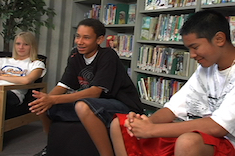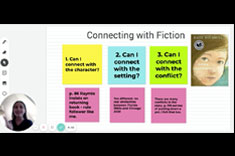It’s still dark outside when I descend the stairs, careful not to wake my sleeping children with sounds of creaky floorboards. When I arrive at the mat, I cross my legs and stretch my arms above my head, tilting toward the right, then all the way to the left, tenting my fingers once I reach the ground. So begins my daily yoga practice.
I move. I breathe deeply and hold shapes. I try to clear my mind. At times I close my eyes, visualizing how I’ll take these ideas off the mat and into daily life. How can I hold space for calm when life feels frenzied? How can I cultivate patience when tasks stack up? How can I recenter importance? What are my goals?
Daily yoga practice allows me to move from visualization to approximation and practice, then on to transference and mastery. There are times when I set intentions and goals, reach them, and celebrate the process that took me there. At other times, I celebrate the approximate achievement of the pose, give myself grace, and try another day. If I can envision it, I can practice it, and at some point, it becomes part of my seamless repertoire of yoga skills. In my daily practice, routine and flow is integral, because it allows for transference and incorporation, from mat to my everyday life.
These yoga strategies requiring visualization, practice, and eventual celebration mirror literacy workshop teaching. Teachers challenge students to transfer strategies from minilessons to independence, from small groups or conferences to beyond classroom walls. Students practice. They rehearse, set goals, and celebrate once they get there. Yoga practice mentally prepares me to face the world, just as workshop prepares kids, with visualization, practice, routine, and transference, to incorporate literacy strategies into their repertoires beyond school assignments.
Visualization: You Try
“How many of you are going to go back to your story and revise with setting details in mind?” said Mrs. O, a teacher I observed recently via Zoom. “What will you add? Give me a thumbs-up if you have a plan for writing time in mind.”
Minilessons like Mrs. O’s support rehearsal, planning for independent work time, and incorporation of minilessons into solo routines. By asking kids to envision their independent practice before moving away from the lesson, teachers set kids up for eventual independence. Visualizing their work time supports students in their own planning and writing execution.
Reflection Questions:
- In what ways can I ensure students have a plan for time outside of direct instruction?
- How might students signal their ideas to me before moving off the “mat” and into independent practice?
These life lessons to visualize goals, plans, and daily routines help workshop learners in the classroom and in the real world.
Approximation and Practice: Process, Not Perfection
Teachers carve out space for students to challenge themselves in the everyday practice of reading and writing—stretching their literacy limbs, gaining strength in those critical muscles. Sometimes checklists guide work time; sometimes there’s freer rein. Often, teachers highlight tools and reminders that support independence. Like yoga, strengthening craft arises from consistent routine and practice. Students need isolated time to write, honing specific skills when given consistent time to try.
Reflection Questions:
- What visuals or tools might I have at the ready for students who need reminders during independent practice time?
- In what ways will the skills and strategies I teach support my students outside school walls?
Making space for shapes in yoga is not dissimilar to the independent trial and error our kids work toward each day. Does every day’s practice look beautiful and balanced? Not always. Are there days when I am reluctant to try strenuous poses—even ones I held on previous days—or truly feel unable to hold the shape? Definitely. It is a journey. It is a test of endurance. As a yogi and a workshop instructor both, stamina and strength are my goals.
Mastery and Incorporation: Part of the Repertoire
Mr. W is teaching a small group of second graders virtually. There’s a page from a Mo Willems Elephant and Piggie book on the screen. He says, “When you use capital letters strung together, you’re telling your readers to raise their voices. You’re basically telling them to shout! So today when you go back into your writing, look at the dialogue. Are there words you want to pop? Every time you write, this is a move you might try.”
As the kids nod and then turn eyes toward their own pages, I observe those little pixelated boxes. Four of the six are already moving their writing utensils, ostensibly deciding which words in their writing they deem worthy of making all caps. One student asks if it makes sense to add additional Os to the end of sooooo; Mr. W commends the child for remembering a previous strategy. It is with this challenge for transference beyond the day’s writing task that Mr. W sends the kids away—to log off for the afternoon. He reminds them, “Each and every time you’re writing dialogue, you know you can capitalize or lengthen words to emphasize your point.”
It was in Mr. W’s final words that the students found their plan for the day. When he said “each and every time,” he moved ownership of the strategy to scholars, allowing them to internalize and accept it as one in their own repertoires.
Across a full workshop flow, teachers might use these questions to guide their thinking around workshop transference:
- How can I ensure my students have a plan for independent work time, visualized and ready to go?
- How can students carry minilesson mantras into their daily practice, ensuring transference toward independence?
- How does my framework for teaching students help them learn about routine, consistency, and transference?
Back on the Mat
I’m back on my mat and breathing, lengthening my exhales to equal my inhales. I recenter around the lessons I’ve been practicing:
- Take a WOW moment if I feel stressed (wait, oxygen, water).
- Name how I’m feeling when the emotions overwhelm me (“I felt frustrated when…”).
- Stand taller when my confidence wavers.
- Envision a smooth day, free of too many hiccups.
It is the visualization on the mat, the routine of this practice, and the approximation that allows me to grow toward mastery. The process is everything. Practice is critical. It is an imperfect adventure. And yet, I approach the mat anew each morning in the darkness, appreciating that time to try.
As the old adage goes, “Don’t practice until you get it right. Practice until you can’t get it wrong.” From visualization to daily approximation to celebration of the yoga experience, I need all the steps that get me there.
So true, too, for workshop teaching: Honor the journey.






